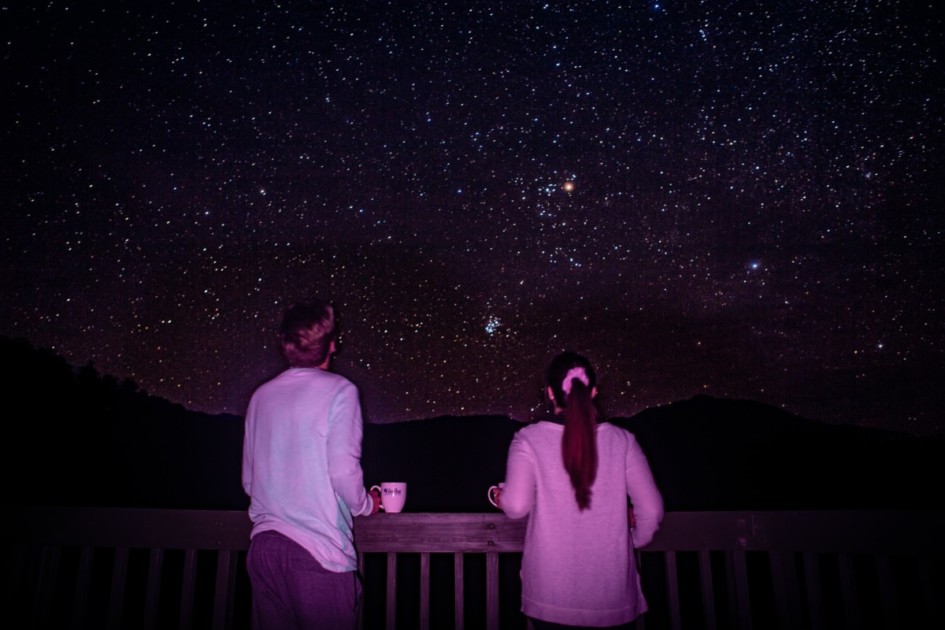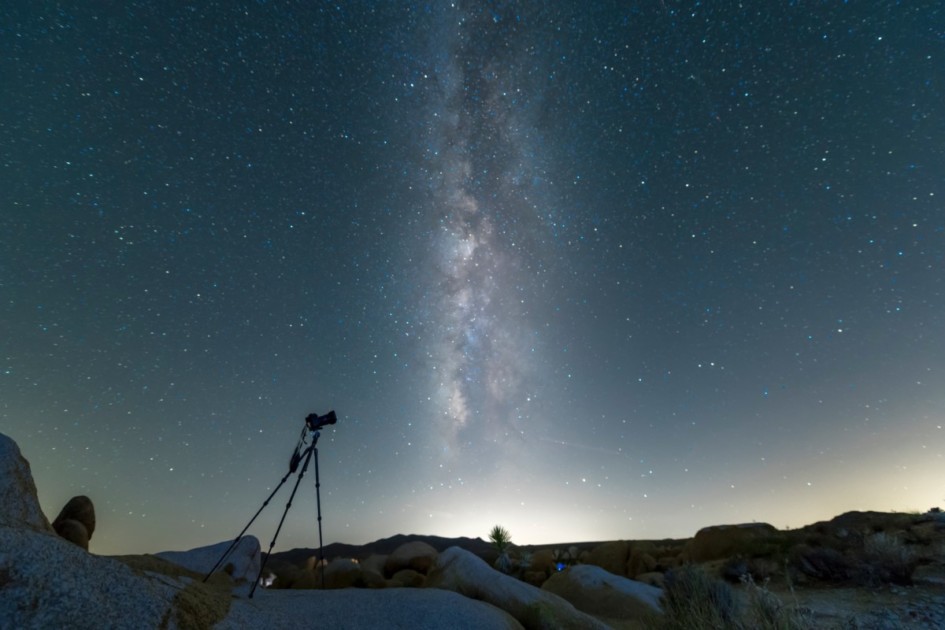With summer right around the corner, warm nights give people the perfect opportunity to venture outside and enjoy nature. From BBQs and movie nights to yard games and camping, you don’t even have to leave your backyard to make the most of summertime.
Stargazing is another hobby anyone can pick up and enjoy from their backyard, whether you live in a townhouse in Miami, FL, rent a home in Portland, OR, or anywhere in between. A clear night sky filled with stars just can’t be beat, and it’s a great way to connect with nature and the universe around us. Don’t know where to start? For this backyard stargazing guide, we asked experts to share their best advice for anyone interested in stargazing so you can sit back and enjoy the night sky.

Begin stargazing around 10:30 PM for optimal observing
The summer skies are ideal for observing the stars, no matter where you are – though dark skies sure help. The challenge of summer is that the sun sets late and rises early, meaning that the hours for observing are short. Typically, good observing doesn’t start until about 10:30 PM, though stars start to be clearly visible at 9:30 PM. To find objects to observe, whether using a telescope, binoculars, or the naked eye, we suggest downloading the monthly star map at skymaps.com, which provides a list of the best objects, as well as a general sky map for each month. The winter features many bright stars and longer nights, but it can be quite cold.
Because sky watching involves standing around quite a bit, it’s always a good idea to dress for temperatures about 20 degrees colder than the thermometer says. Avoid flashlights unless you cover the lens with red plastic, and allow at least 15 minutes for your eyes to adjust to the darkness.- Northeast Kingdom Astronomy Foundation in Peacham, VT
Lean on technology to make the most of your time
Artificial light pollution has robbed us of the beautiful star-filled night skies that thrilled ancient stargazers. But today’s technology has also given back at least as much as it’s taken away. While people of the past could see many more stars in their much darker, clearer skies, they had no idea what they were looking at. But we do! That’s an advantage anyone can grasp and hold onto, literally, in the palm of their hand. Smartphone apps, like the brilliant “Sky Guide,” give us advantages that would make the Roman and Greek gods of traditional sky lore green with envy. Standing in your yard and holding your phone outstretched to the heavens, these apps overlay an Augmented Reality view of the contents of the sky you’re seeing, so you can touch, identify, and learn about each constellation, star, planet, or satellite you might see. Be sure to check out the scientific star tales apps like “Sky Guide” offers.
With nothing more than a smartphone, your eyes, and, if you have them, a simple pair of binoculars, your backyard can become a launchpad for boldly going where you’ve never gone before. – Greensboro Science Center in Greensboro, NC
Start with stars like Sirius, Arcturus, or Vega
Enjoying the night sky and stargazing from your backyard oasis doesn’t have to be too technical or complicated. You don’t have to own a telescope to start your stargazing journey. Even in the case of considerable light pollution around you, it’s possible to see famous and bright sky objects with a naked eye. We encourage beginners to start with the brightest stars in the night sky like Sirius, Arcturus, or Vega. These can be located quickly without any skills. When you can find famous naked-eye stars, move to the next level by stargazing with binoculars since that will open a whole new spectrum of stars to watch. The best conditions to watch the stars are when the moon is dim and doesn’t radiate much light. At the same time, the best seasons for star watching are spring and autumn – the night is longer, yet the air can be warm enough to enjoy your time. – Star Registration
Use a flat surface and find the brightest star in the sky
To achieve an incredible stargazing experience, set up your telescope on a flat surface at least an hour before viewing to allow the optics to adapt to the weather conditions. Ensure that the lens does not point to streetlights, house lights, etc. Start your observation by finding the brightest star in the sky. For best results, use a skywatching software like Dedicated Stars’ digital planetarium platform to map out the night sky. – Dedicated Stars

Prepare for the weather
The best time to stargaze is any day, 30-45 minutes after sunset. Depending on the time of year, you can expect to see some of the planets within our solar system. During the summer months, you may see large bright, tightly formed star clusters called globular clusters, while you will see open clusters during the winter and spring months. Good examples of this would be the Hercules Cluster (Messier 13) during the summer and fall and the Pleiades (Messier 45) during the winter and spring.
Use a telescope for spotting distant objects like planets, galaxies, nebulae, and globular clusters. Use binoculars for open star clusters. You can use both a telescope and binoculars for the Moon. And for meteor showers, you only need a blanket and your favorite tunes.
Always prepare for your weather conditions, and don’t forget bug spray during the summer and warm socks during the winter. There are great websites dedicated to giving you the best possible forecast for stargazing, such as Clear Dark Sky and Astrospheric.
Don’t be afraid to use a phone app or a program to observe the planets. My two favorites to use are SkySafari for the iPhone and Stellarium for the computer. If you want to learn about our universe, visit NASA Eyes, and if you want to track the International Space Station, sign up for alerts with Spot the Station from NASA. – Katherine Troche, Kuiper Kat’s Astronomy
Stargaze often and at different times of the month
Different constellations are in view each season, so stargaze often. Allow your eyes time to adjust to the dark so you can see more objects with your naked eye. If you need help identifying single stars, constellations, or planets, use a stargazing app, but turn the brightness down to save your night vision. Try stargazing at different times of the month. You can see more stars when there is no moon, but the moon also offers a beautiful night sky experience.
Tune into the podcast Night Sky Tourist for a stargazing tour. Listeners can take the podcast outside for help identifying that week’s visible constellations and planets. You’ll also hear ancient star stories associated with the constellations. – Vicky Derksen, Night Sky Tourist
Point your feet south
The night sky is confusing because everything moves from hour to hour and from night to night. Here’s a practical way to become clear about this movement. Lie on a lawn chair with your feet pointing and watch a bright star, comparing its position with a tree, for example. You’ll find it moves rightward along a path like an arch. Stars revolve around the North Pole star from east to west because the Earth is spinning in the opposite direction. – Guy Ottewell, Universal Workshop
Use a flat surface and find the brightest star in the sky
To achieve an incredible stargazing experience, set up your telescope on a flat surface at least an hour before viewing to allow the optics to adapt to the weather conditions. Ensure that the lens does not point to streetlights, house lights, etc. Start your observation by finding the brightest star in the sky. For best results, use a skywatching software like Dedicated Stars’ digital planetarium platform to map out the night sky. – Dedicated Stars
Consider special filters to enhance objects
Use a red-filtered flashlight, an observation log, binoculars, a telescope, and a planisphere, commonly called a Starfinder, to locate stars and constellations and the celestial objects within their boundaries.
Observe the phases of the Moon with its monthly orbit around the Earth using a calendar and peer into numerous impact craters on its surface. Using the Sky & Telescope and Astronomy magazines, discover when and where to look for planets and invest in a set of star charts. If you live in the city, consider using special filters to enhance dim objects by increasing contrast and blocking wavelengths associated with incandescent and fluorescent lighting to allow a very high transmission of wavelengths of light coming from faint clouds of gas and dust space. Astronomy is truly an incredible experience for young and old alike. From your backyard, you can see lunar and solar eclipses, the ice crystal rings of Saturn, streaks of light across the sky from meteor showers, and celestial interlopers known as comets, all seen from the surface of our natural spaceship, Earth. – Kevin Manning, Astronomer at Look Up to the Stars

The best time to stargaze
Urban light pollution makes backyard stargazing tricky, but you can still make out major constellations and planets if you wait for the right time.
Best days for stargazing
- Choose the nights of the new moon or days approaching it or 2 to 3 days just after it.
- Check the moonrise and moonset times on the chosen day.
- Check to make sure the sky is cloudless and clear with no chance of rain.
- Time stargazing between sunset, moonset, and moonrise, sunrise, i.e., when there is no moon and sun in the sky.
Best seasons for stargazing
- During winter/fall, Earth faces only 25% of the Milky Way, so stars don’t appear as dramatic.
- During summer, Earth faces 75% of the Milky Way, so we see a dramatic night sky. You can see Scorpius, Sagittarius, Leo, Ursa Major, Summer Triangle (Deneb, Vega, Altair), North Star, Mars, Jupiter, and Saturn.
Recommended gadgets for stargazing
- Pentax K-3 II 10-20mm, lens f/4, aperture ISO (up to 12800), 30 sec + exposure time. Bulb mode with a trigger can also be used.
- Tripod is a must. Care must be taken when increasing ISO beyond 6400 as it introduces noise in the picture. – Travel as Family
Allow your eyes to adjust and retain your night vision
The best time to enjoy backyard stargazing is a clear night without Moon illumination. Choose a spot where you can see the stars. Turn off any lights you can control and block out others by placing something opaque in front of them. Give your eyes several minutes to adapt. If you need to read sky charts or find your way around, use a light source with a red filter. It will help you retain your night vision for the best views of the night sky. – Telescope Nights
Plan a stargazing trip to a rural destination
Planetariums, eclipses (both solar and lunar), planets (when available), the moon, bright meteors, and bright stars are all wonders that urban residents can enjoy. Check online for when and where to see the International Space Station, planets, eclipses, and meteor showers. I also urge you to plan one trip to an open space at least 50 miles from any city on a clear and moonless night and watch the nightfall. Late on summer nights, the Milky Way is a jaw-droppingly glorious sight. – Dave Manness, Planetarium Supervisor at Museum of Science & History in Memphis, TN
Enjoy the beautiful night sky
Try to find the darkest place outside your residence. The darker it is, the more you’ll see. Just lay down and look up. Let your mind wander and your body relax. You’re looking back in time, literally. The light emitted from the closest star has taken at least 4 years to get to earth, and for other stars visible to the naked eye, up to 16,000 years for light to reach your eyes. Take a moment and wrap your head around that. Want to see a shooting star? Check out “stardate.org” to discover what shooting stars are and the best time to look for them. You can also download an interactive 3D astronomy app that helps identify the celestial bodies and constellations you are looking at. Enjoy your ride on the spaceship Earth. – Moravian Academy in Bethlehem, PA

 United States
United States Canada
Canada